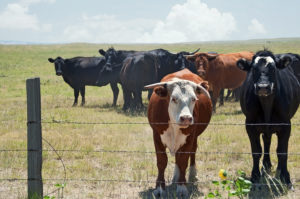 Changes in dairy-ration formulation and feed management can help prevent reductions in dry matter intake during hot weather, advises Alvaro Garcia, South Dakota State University Extension dairy specialist.
Changes in dairy-ration formulation and feed management can help prevent reductions in dry matter intake during hot weather, advises Alvaro Garcia, South Dakota State University Extension dairy specialist.
“Heat stress occurs when cows cannot dissipate enough heat to maintain their core temperatures below 101.3°F,” says Garcia. “Internal heat production increases at higher dry-matter intakes, which makes high-producing cows more sensitive to heat stress. Body-temperature increases of just 2.7° have been shown to result in intake reductions of almost 13 lbs.”
When intake drops, nutritionists often formulate energy-dense rations with more concentrates and less forages. That’s a sound practice, says Garcia, if there’s sufficient effective fiber to stimulate rumination and maintain adequate rumen pH.
“Heat-stressed cows reduce rumination and tend to select finer feed particles. This combination of more concentrated rations, together with a reduced capacity to buffer rumen pH, increases the risk of acidosis during hot weather. These changes can be observed in farms by a reduction in milkfat and higher incidence of lameness.”
Here’s Garcia’s checklist of feeding strategies that help reduce excessive drops in intake:
- Feed in early mornings or evenings so the highest metabolic heat production doesn’t coincide with maximum environmental temperatures.
- Avoid feed shortages in the bunk. When offering fresh feed, there needs to be 0.5-5% refusals. Target refusals by pen as follows: fresh cows, 3-5%; high pen, 1-4%; low pen, 0.5-3%. Remove refusals at least once a day to minimize heating of the fresh feed.
- Feeding a TMR is better than supplying feedstuffs individually.
- Silages improve ration acceptability and have low pH, so they slow mold and yeast growth and reduce heating.
- Including other high-moisture products such as sweet bran, beet pulp or wet distillers grains also helps increase ration acceptability.
- Add water when ration dry matter exceeds 60% to bring it down to 50%. Water conditions the ration, reduces dust and increases its acceptability.
- Feeding at least twice a day and mixing the TMR immediately prior to feeding helps reduce heat buildup in the feed bunk.
- Push up feed 8-10 times a day. Make sure there’s feed available all along the feed bunk; cows tend to concentrate and eat close to fans or water troughs.
- Manage the silo face to prevent secondary fermentations and heating. Defacer equipment minimizes air infiltration. Remove at least 1’ daily from all the exposed face, and use all removed silage as soon as possible.
- Use feed additives to control mold growth and reduce secondary fermentations and excessive heating in the feed bunk. Most of these products contain propionic acid.
- Feed high-quality, highly digestible forages. Target minimum effective NDF at 22% of the diet dry matter.
- Avoid excessive particle breakdown during mixing. Most TMR mixers have three- to six-minute mixing times when they have been turning during loading. Check particle size with a Penn State forage particle separator. The top sieve of a three-sieve separator should retain 2-8% of the diet.
- Feed additives such as yeasts, fungi and/or probiotics can improve rumen health.
- Increase sodium bicarbonate to 1% of the diet; also supply it free choice.
- Heat-stressed cows lose lots of minerals. Increase sodium, potassium and magnesium to at least 1.5, 0.45 and 0.35% of the diet dry matter, respectively. White salt (sodium chloride) is a source of sodium; however it’s important to maintain chlorine at 0.35% of the diet dry matter, and not exceed 0.5% white salt.
- Use rumen-protected fat to increase the ration’s energy density, but avoid unprotected fats such as vegetable oils or tallow.
- Maintain high levels of starches and sugars in the diet (26 and 8%, respectively). Cereal grains that contain starch with slower degradation rates, such as corn and milo, are better than wheat and barley, which have faster degradation rates.
- Place water troughs in shade and clean them frequently. Cows prefer to drink water with a temperature between 63 and 82°F. If the water isn’t cool enough, it further adds to the heat load.
Source: Hay & Forage




